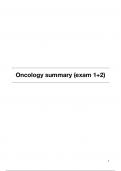Summary
Summary Oncology (AB_1184) partial exam 1+2
- Module
- Institution
- Book
Complete summary of the Oncology course (AB_1184) from the 2nd year of biomedical sciences, VU Amsterdam. This summary contains all information needed for partial exam 1 and 2, and includes all the material from the lectures and the book that was required for this course, together with the seminars...
[Show more]




